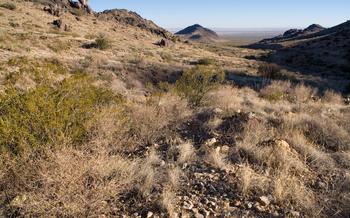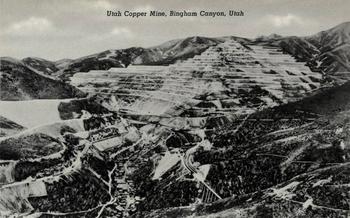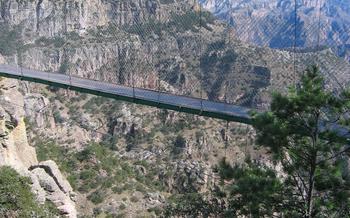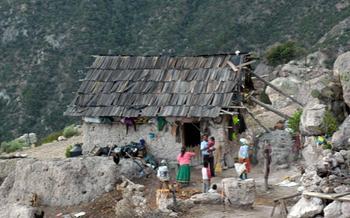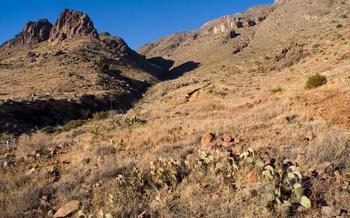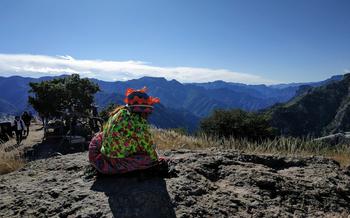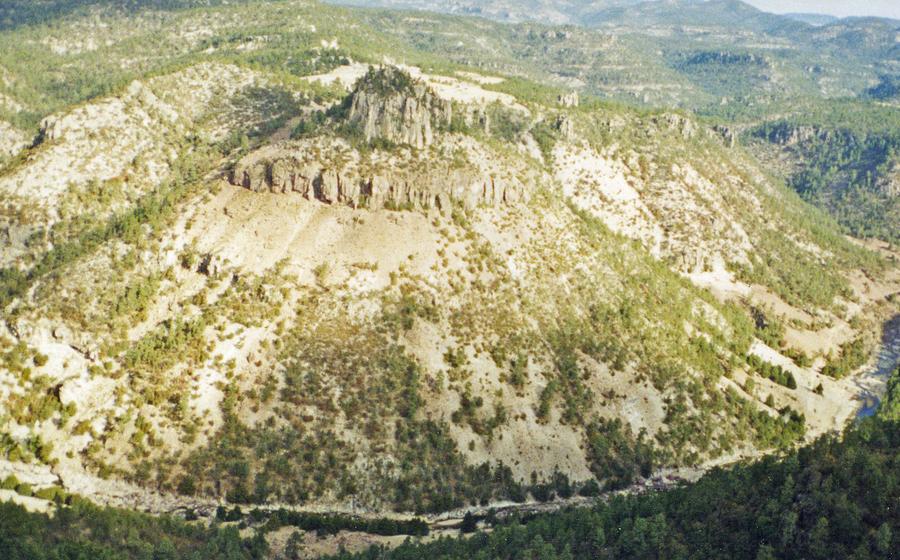
Museum of Sacred Art
- Historical Background
- Architectural Marvel
- Diverse Collection
- Religious Significance
- Cultural Insights
- Interactive Exhibits
- Hands-on Experiences: A Deeper Connection
- Local Artisans and Craftsmen
- Community Engagement:
- Sustainable Tourism:
- Photography and Videography:
- Accessibility for All:
- Future Plans and Exhibitions:
- Insider Tip:
Historical Background
The Copper Canyon region, nestled in the heart of Mexico's Sierra Madre Occidental, holds a rich tapestry of history and cultural heritage. The Museum of Sacred Art, located in the picturesque town of Creel, stands as a testament to the region's profound religious and artistic traditions. Established in 1987, the museum occupies a beautifully restored colonial building that once served as a Jesuit mission. Its collection showcases a diverse array of sacred art, offering visitors a glimpse into the profound influence of the Catholic Church in the development of the region.
The museum's collection includes exquisite paintings, sculptures, textiles, and religious objects that date back to the colonial era. These precious artifacts not only demonstrate the artistry and craftsmanship of the region's indigenous communities but also shed light on the unique blend of indigenous and European cultural influences that shaped the region's identity. The Museum of Sacred Art serves as a vital repository of cultural heritage, preserving and showcasing the sacred art that has played an integral role in the lives of the Copper Canyon communities for centuries.
Architectural Marvel
The Museum of Sacred Art is housed in a beautiful and historically significant building that is a testament to the region's rich cultural heritage. The building's architectural style blends colonial and indigenous influences, creating a unique and visually striking structure. The facade is adorned with intricate carvings and sculptures, depicting religious scenes and symbols. The interior of the museum features high ceilings, arched doorways, and stained glass windows, creating a sense of awe and reverence.
The museum building has undergone extensive restoration efforts in recent years, ensuring its preservation for future generations. These efforts have been recognized and awarded, highlighting the importance of the building as a cultural and historical landmark. The restored building not only serves as a showcase for sacred art but also stands as a symbol of the region's resilience and commitment to preserving its cultural identity.
Diverse Collection
The Museum of Sacred Art in Mexico's Copper Canyon region houses a diverse collection of sacred art pieces that span different periods and styles. From intricate paintings and sculptures to finely woven textiles and religious objects, the museum offers a glimpse into the rich cultural heritage of the region. Visitors can admire works created by local indigenous communities, as well as pieces brought by Spanish missionaries and settlers. The collection includes notable paintings depicting biblical scenes, sculptures of saints and angels, and elaborately embroidered vestments used in religious ceremonies. The museum also features a collection of traditional masks and ceremonial objects that provide insights into the indigenous cultures of the Copper Canyon region.
Religious Significance
The sacred art pieces housed in the Museum of Sacred Art hold deep religious significance for the local indigenous communities and the Catholic Church. These artworks serve as tangible expressions of faith, representing the spiritual beliefs and practices of the region. They have played a crucial role in religious rituals and ceremonies, serving as focal points for devotion, prayer, and contemplation. The museum's collection showcases a rich tapestry of religious traditions, including Catholicism, indigenous beliefs, and syncretic practices that have evolved over centuries.
The artworks depict biblical scenes, saints, and religious figures, as well as symbols and iconography that hold spiritual meaning for the local communities. They serve as portals to the sacred, inviting viewers to engage with the divine and explore the mysteries of faith. Through these artistic representations, visitors can gain insights into the religious practices, beliefs, and cultural heritage of the Copper Canyon region.
Cultural Insights
The Museum of Sacred Art in Mexico's Copper Canyon region offers a profound glimpse into the cultural heritage of the area. Through its collection of sacred art, the museum showcases the unique symbolism and iconography used by indigenous communities to express their beliefs and traditions. Visitors can explore the stories and legends depicted in the artworks, which provide insights into the cultural identity and worldview of the region's people. The museum also highlights the role of sacred art in religious rituals and ceremonies, demonstrating the deep connection between art and spirituality in the local culture. By preserving and promoting these cultural traditions, the museum plays a vital role in fostering a sense of pride and identity among the indigenous communities of the Copper Canyon.
Interactive Exhibits
The Museum of Sacred Art offers a range of interactive exhibits and educational programs to enhance visitors' understanding of the collection. Guided tours led by knowledgeable docents provide insights into the history, symbolism, and cultural significance of the artworks. Visitors can participate in workshops and classes to create their own sacred art pieces, learning traditional techniques and exploring the creative process firsthand. Multimedia displays and touchscreens offer additional information about the artworks and the museum's history. These interactive elements engage visitors of all ages, making the museum a dynamic and educational experience.
Hands-on Experiences: A Deeper Connection
Visitors to the Museum of Sacred Art have the opportunity to go beyond mere observation and actively engage with the collection through hands-on experiences. Workshops and classes led by skilled artisans provide visitors with a chance to create their own sacred art pieces, using traditional techniques and materials. These hands-on activities foster a deeper connection with the museum's collection, allowing visitors to gain a firsthand understanding of the artistic process and the significance of the sacred art.
One visitor, Maria, shared her experience of participating in a pottery workshop at the museum. She learned the traditional techniques of shaping and glazing clay, and created her own unique piece of pottery inspired by the museum's collection. Maria expressed her delight at the opportunity to not only learn about the art but also to create her own piece that she could cherish as a reminder of her visit.
These hands-on experiences not only provide a fun and engaging way to interact with the museum's collection but also promote cultural preservation and appreciation. Visitors gain a deeper understanding of the skills and techniques used by local artisans, and the significance of their work in preserving the cultural heritage of the region.
Local Artisans and Craftsmen
The Museum of Sacred Art is not just a repository of sacred artifacts; it is also a living testament to the skill and dedication of local artisans and craftsmen. Many of the pieces in the collection have been lovingly restored or created by local artisans using traditional techniques and materials. These artisans are the custodians of a rich cultural heritage, and their work helps to keep alive the traditions of their ancestors.
One such artisan is Don Juan, a master woodcarver who has been working with wood for over 50 years. Don Juan's work is characterized by its intricate detail and his deep understanding of the natural beauty of wood. He has carved many of the statues and altarpieces in the museum, and his work is a testament to his skill and devotion.
Another local artisan is Doña Maria, a master weaver who specializes in creating traditional textiles. Doña Maria uses natural dyes and fibers to create vibrant and colorful textiles that are used for clothing, blankets, and other household items. Her work is not only beautiful but also functional, and it is a vital part of the local culture.
By showcasing the work of local artisans, the Museum of Sacred Art helps to preserve and promote the cultural heritage of the Copper Canyon region. Visitors to the museum can learn about the traditional techniques and materials used by local artisans, and they can appreciate the beauty and craftsmanship of their work.
Community Engagement:
The Museum of Sacred Art is not merely a repository of sacred artifacts; it serves as a vibrant hub for community engagement and cultural preservation. The museum actively collaborates with local schools, community groups, and indigenous organizations to promote cultural understanding and appreciation. Educational programs, workshops, and outreach initiatives are organized to engage the community and foster a sense of ownership in the museum's mission. The museum also participates in community events and festivals, showcasing its collection and providing a platform for local artisans and performers to share their talents. Through these initiatives, the museum fosters a strong connection with the community, ensuring that the legacy of sacred art and cultural traditions continues to thrive.
Sustainable Tourism:
The Museum of Sacred Art is committed to promoting sustainable tourism practices that minimize environmental impact and respect the cultural traditions of the local communities. The museum utilizes renewable energy sources and implements waste reduction initiatives to reduce its carbon footprint. It also collaborates with local businesses to support the community's economy. Visitors are encouraged to respect the cultural heritage of the region by dressing modestly, avoiding photography in sensitive areas, and refraining from purchasing souvenirs that exploit indigenous cultures. By embracing sustainable tourism, the Museum of Sacred Art contributes to the preservation of the Copper Canyon's unique environment and cultural heritage for future generations.
Photography and Videography:
Capturing the beauty and significance of the Museum of Sacred Art through photography or videography is a rewarding experience. While respecting the museum's policies, visitors are encouraged to take photos and videos to share their experiences with others. For the best shots, consider positioning yourself to capture the interplay of light and shadow on the artworks, creating dramatic effects. Experiment with different angles to showcase the intricate details and symbolism of the pieces. Share your creations on social media, tagging the museum to help promote its collection and inspire others to visit. Your photos and videos can serve as a lasting reminder of your journey into the realm of sacred art in the Copper Canyon.
Accessibility for All:
The Museum of Sacred Art is committed to providing an inclusive and welcoming environment for all visitors, regardless of their abilities. The museum features wheelchair ramps and accessible restrooms, ensuring that visitors with mobility challenges can navigate the space with ease. Audio guides are available for visitors who are deaf or hard of hearing, allowing them to experience the collection in a meaningful way. Furthermore, the museum offers sign language interpreters upon request, facilitating communication and understanding for visitors who are deaf or hard of hearing. The museum's staff is trained to be sensitive and accommodating to the needs of all visitors, ensuring that everyone has a positive and enriching experience.
Future Plans and Exhibitions:
The Museum of Sacred Art is continuously evolving and expanding its offerings to visitors. Keep an eye out for upcoming exhibitions and events that delve deeper into the cultural and religious heritage of the region. The museum has plans for renovations and expansion to accommodate its growing collection and to provide a more immersive experience for visitors. Your support and contributions play a vital role in sustaining the museum's mission. By visiting, donating, or volunteering, you become a part of preserving and celebrating the sacred art of the Copper Canyon region. Plan your return visits to witness the museum's ongoing transformation and discover new treasures that await you.
Insider Tip:
For an unforgettable experience, venture beyond the main galleries of the Museum of Sacred Art. In a secluded corner of the museum, you'll find a hidden gem – a small chapel that has been preserved in its original state. Step inside to admire the intricate altarpieces, stained glass windows, and faded frescoes that tell the stories of saints and miracles. This hidden sanctuary offers a glimpse into the deep spirituality and artistic traditions of the region, making it a must-visit for those seeking a truly immersive experience at the museum.
